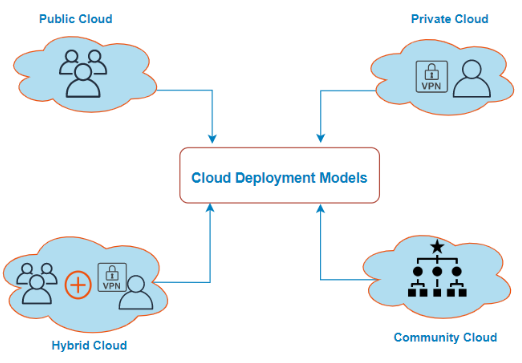cloud deployment models
cloud deployment models
Cloud publishing models are the provision of cloud computing services by publishing them in several clouds, and the classification of these clouds is based on the accessibility and use, the ownership of the cloud, or lack thereof, its size, or the purpose of it, and the advantages of cloud computing to the user.
Cloud deployment models
- Public Cloud
- Private Cloud
- Hybrid cloud
- Cloud community
Public cloud
The public cloud is the cloud with cloud services open to all users, whereby anyone can access its infrastructure, systems, and everything provided by its cloud service providers with ease and without paying any fees for that.
Among the computing companies that provide public cloud service: Microsoft, Google, Amazon, and IBM, among others.
The public cloud is similar to cloud hosting that is fully managed by a cloud service provider and allows corporate or individual customers to use their free resources from anywhere and at any time over the Internet, without the user incurring the costs of these resources or worrying in managing and maintaining them.
In the public cloud, there are limited free resources, but if the user wants to use more resources, he can do so, as they can be flexibly expandable, and he will pay for the additional resources that are not free only.
The public cloud is characterized by its flexibility, reliability, and low cost, but it is less secure than other cloud models and has low privacy.
Examples of generic cloud publishing models include:
Amazon Elastic Compute Cloud (Amazon EC2), Microsoft Azure, Google App Engine, IBM Cloud.
Private cloud
It is similar to the public cloud in terms of preparing the infrastructure to some extent, but it differs in it that it is not available to everyone but rather is owned by one party, a company, or individuals, and therefore it is sometimes called an internal cloud.
This private cloud gives access rights to all who are inside the organization or affiliated with it so that they can access its systems and use the infrastructure, programs, and all its features. This indicates the existence of a security and protection system for the private cloud to obtain a secure and impenetrable work environment to keep its data private.
The cloud service provider provides advanced firewalls that are supervised by the technology department of the institution, allowing only those authorized to enter the private cloud, and this gives great control over data and increases its security and privacy.
The private cloud is:
- Private, secure, and only authorized users can access the cloud and share the use of its resources.
- It has more control over its resources than the public cloud, as only those who have access to the cloud use its resources
- Hosted resources are of limited size and not easily scalable as they are in a public cloud
- Expensive because it is intended for a specific destination
- Due to its peculiarity, it can be accessed locally and difficult to access globally
Community cloud
A community cloud is similar to the private cloud, as it is dedicated to a specific community, but it differs from it by a group of users, the private cloud is allocated to one company and a group of employees within it, and the community cloud is directed to all companies affiliated with this private community, so the institutions affiliated with the same community share infrastructure, resources and even in some cases data.
An example of a community cloud: the health sector community, where different health sector institutions share this cloud to use and benefit from it, such as sharing patient data stored in the cloud to view their disease records to find out their disease cases.
Features of community cloud
- It contributes to reducing costs, and it is more expensive compared to the public cloud, but it has better advantages than the public.
- Increase security and privacy
- Easy to share data
Hybrid cloud
It is based on a combination of the aforementioned clouds, which means it can be a public, private, and social cloud at the same time according to the user’s needs.
For example, the user may need some of the services provided by the public cloud and use them, then he needs to give privacy to some business, so he reserves a private cloud, and so on, and so it is in an integrated hybrid cloud separated by a firewall to protect the privacy of data.
Hybrid cloud has many features
- Flexibility and is scalable
- Cost-effective
- Safe to use
You may also like to read this article: Cloud Services Models




Comments
0 comments